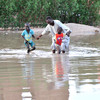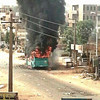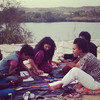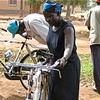South Sudan’s women in the spotlight [part 1]
When we were in the bush we divided the work into two. Three quarters of the ladies took care of the frontline soldiers, the children, the widows, orphans and disabled. A quarter of them were soldiers like me. The three quarters, they were civilians but they were also soldiers. At that time, everybody was a soldier -- even if you are not trained, you are a soldier. You know how to look after yourself, you know which direction you are going to. Everybody was a soldier.”
Many of the female combatants interviewed by author Lydia Stone for ‘Hope, Pain and Patience in South Sudan’, echoed the sentiments of the quote above. Even those who remained far from the frontline considered themselves fighters. While only some men share with women this expanded definition of ‘soldier’ or ‘combatant’, one attitude common among men is that, far from denigrating the supportive roles played by women, they agree that these contributions were essential to the war effort, and that they could not have survived without them.
Keeping up the reproductive front
The Sudan People’s Liberation Army (SPLA) flirted briefly with the idea of using women as fighters. The Kateeba Banaat (literally translated as ‘The Girls’ Battalion’) was formed by the SPLA in 1984 as an all-female fighting force. Although its existence was relatively short-lived, it is today spoken of in folkloric terms. Subsequent female battalions were established but were given secondary roles such as providing logistical and administrative support behind the frontlines.
Other resources that focus on gender in South Sudan:
Small Arms Survey’s Human Security Baseline Assessment for Sudan and South Sudan
UNICEF in South Sudan
United States Institute for Peace
Women for Women in South Sudan
UNDP in South SudanFor the late John Garang, leader of the SPLA during the war, the decision to keep women away from the frontline was based on a long-term strategy for the war. He believed that the war would endure for decades. With this in mind, and with so many dying in combat, women had to be kept away from the fighting so that they could keep up the ‘reproductive front’.
By and large, the women interviewed framed this as a positive policy that respected the vital roles of women both in the war and for the future of South Sudan. Indeed many of the women interviewed complained that because the war kept them separated from their husbands so much, they were prevented from having as many children as they would have wished. Many women described how they had travelled to the frontline specifically to see their husbands and to become pregnant.
Women on the frontline
Of course, not all women agreed that their role was to reproduce. Some women went to extraordinary lengths to fight alongside their male colleagues.
Janet Bulen Mofatta, for instance, received the same training as her male colleagues and was upset when she and the other women were assigned duties such as cooking and caring for the wounded while the men would carry out an assault on Yei. She and her aunt left the camp, claiming to go fetch water, but instead followed the men as they passed on their way to battle.
Download the bibliography:
‘We were all soldiers’: Female combatants in South Sudan’s civil warBy the time the two women were discovered, it was too late to send them back. So the leader of the force allowed them to continue with the group and to participate in the attack. The SPLA succeeded in taking Yei. Janet claims that not only were the women as brave and fierce as the men around them, but their presence actually spurred their male colleagues on. Janet’s performance in the assault on Yei did not go unnoticed. Although she was not permitted to return to the frontline, she worked closely with John Garang for the remainder of the war.
Other armed groups in South Sudan did not have the same policy of keeping women away from the frontline. In areas where other armed groups were active, more women took part in frontline combat. Women also performed a variety of other roles, many of which were highly dangerous. Joyce Richard Piapia posed as a trader, travelling to Khartoum in North Sudan, and feeding information back to her father, who was a senior SPLA commander. Joyce insists that she was as much a combatant as anyone who fought on the frontline, I am not fighting with a gun, but I am fighting with my mouth”.
I cannot smile until Southern Sudan is free
The women who gave so many years of their lives to the war in South Sudan see their happiness as intrinsically linked to their country’s independence. When asked why she didn’t smile while having her photograph taken, Nyakal Kuech Duop, a formidable fighter of Nasir who had survived two Sudanese wars explained simply, I cannot smile until Southern Sudan is free”.
Adapted by Cara Meintjes, from Lydia Stone’s chapter, ‘We were all soldiers’: Female combatants in South Sudan’s civil war” in Hope, Pain and Patience: The Lives of Women in South Sudan. Edited by Friederike Bubenzer and Orly Stern. Photographs by Irene Abdou and Jenn Warren. A Publication of the Institute for Justice and Reconciliation. ISBN Number: 978-1-920196-36-3. Published by Jacana Media. Available from http://www.jacana.co.za/.





